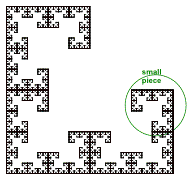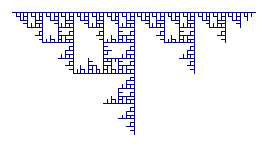
Practice questions:
1. I have a mystery shape that is self similar. I have a specific smaller similar copy of my mystery shape where the enlargement scale factor (the scale factor to make the larger copy from the smaller one) is 5.
A. If the mystery shape was 1-D, how many copies of the smaller shape would you need to build the larger shape?
B. If the mystery shape was 2-D, how many copies of the smaller shape would you need to build the larger shape?
C. If the mystery shape was 3-D, how many copies of the smaller shape would you need to build the larger shape?
2. I have a mystery shape that is self similar. I have a specific smaller similar copy of my mystery shape where the enlargement scale factor (the scale factor to make the larger copy from the smaller one) is 5. If I need 25 copies of the smaller shape to build the larger shape, what dimension (or between what dimensions) is my shape?
3. I have a mystery shape that is self similar. I have a specific smaller similar copy of my mystery shape where the enlargement scale factor (the scale factor to make the larger copy from the smaller one) is 5. If I need 15 copies of the smaller shape to build the larger shape, what dimension (or between what dimensions) is my shape?
4. In this Koch curve, circle two pieces that are the same shape as the whole curve, but at a different magnification. For each of your pieces, tell how much (length scale factor) you would need to magnify them to get the whole thing, and how many of them it takes to make the whole thing:

5A. For the circled similar part of this Sierpinski triangle, tell the scale factor needed to enlarge it to the whole triangle, and the number of copies needed to create the whole triangle.

B. Compare the number of copies for this scale factor to the copies needed for a 1D and 2D shape. What does this tell about the fractal dimension of the Sierpinski triangle?
6A. For the smaller, similar part circled in this fractal, tell the scale factor to enlarge it to the larger whole curve, and the number of copies needed to create the larger whole curve.

B. Compare the number of copies for this scale factor to the copies needed for a 1D and 2D shape. What does this tell about the fractal dimension of this fractal?
7A. In this fractal, circle a piece that is the same shape as the whole curve, but smaller. For your circled piece, tell how much (length scale factor) you would need to magnify it to get the whole thing, and how many copies of it you need to make the whole thing:

B. Compare the number of copies for this scale factor to the copies needed for a 1D and 2D shape. What does this tell about the fractal dimension of the this fractal?